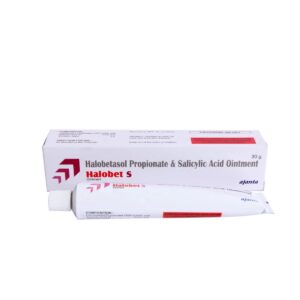HALOBETASOL PROPIONATE + SALIYCLIC ACID
Halobetasol Propionate: Halobetasol propionate is a topical corticosteroid drug used to treat various skin conditions, such as psoriasis, eczema, and dermatitis. It is available in different formulations including creams, ointments, and gels.
The mechanism of action of halobetasol propionate involves its ability to suppress inflammation in the skin by inhibiting the release of certain chemicals called cytokines, which are involved in the immune response. This reduces redness, itching, and swelling associated with skin conditions.
The recommended dose of halobetasol propionate depends on the severity and location of the skin condition being treated. It is typically applied thinly and gently to the affected area once or twice daily. The duration of treatment may vary, but it is generally advised not to use this medication for a prolonged period or on large areas of the body.
Common side effects of halobetasol propionate include skin irritation, burning, itching, dryness, and redness. Prolonged or excessive use of this medication can lead to thinning of the skin, increased risk of skin infections, and other systemic side effects such as adrenal suppression, or Cushing’s syndrome if absorbed in large amounts or over a long period of time.
It is important to follow the directions provided by your healthcare professional and avoid using halobetasol propionate on broken or infected skin, on your face, or in the diaper area of infants. Additionally, inform your healthcare provider about any other medications or skin products you are using, as some interactions may occur.
Saliyclic Acid: Salicylic acid is a medication commonly used for various dermatological conditions. It belongs to the class of drugs known as keratolytics, which means it helps in the removal of dead skin cells.
The primary use of salicylic acid is in the treatment of acne, warts, psoriasis, and other skin conditions characterized by abnormal cell growth. It works by softening and loosening the outer layer of the skin, promoting the shedding of dead skin cells. This unclogs the pores and reduces inflammation, allowing other medications to penetrate deeper into the skin.
Salicylic acid is available in various forms, including creams, gels, lotions, and ointments. The concentration of salicylic acid in these products ranges from 0.5% to 30%, depending on the condition being treated. It is important to follow the instructions provided by your healthcare provider or the product label for the appropriate dose and application frequency.
Like any medication, salicylic acid can cause side effects. The most common side effects include skin irritation, redness, and stinging sensation at the site of application. These side effects are usually mild and resolve on their own. However, if severe irritation or allergic reactions (such as swelling, itching, or rash) occur, it is important to discontinue the use of salicylic acid and seek medical attention.
It is essential to avoid using salicylic acid on open wounds, broken skin, or areas with intense sunburn. It should also be used with caution in individuals with known allergies to salicylates or those who are pregnant or breastfeeding. Salicylic acid can be absorbed into the bloodstream and may interact with certain medications. It is advisable to consult a healthcare professional before using salicylic acid if you are taking any other medications.
In summary, salicylic acid is a keratolytic medication used in the treatment of acne, warts, psoriasis, and other skin conditions. It works by loosening dead skin cells and unclogging pores. It is available in various forms and concentrations. Common side effects include skin irritation and redness. Consult a healthcare professional for the appropriate use and potential interactions with other medications.

